Successful project - user oriented project
Focusing the project on the user's goals, you can create new, convenient and popular services. Moreover, it is possible to create social communications around goods, and this is successfully monetized! That's just ... What will help to take into account the goals of your users? Marketing? Unfortunately, the “frontal” transfer to the Internet of the practice of ordinary marketing does not give a result.
The text of the report of Pavel Konoplitsky at the conference SocialExperience 2008

The success of market leaders and the lack of user information, attempts to use the offline experience of creating a new product or service on the web often turn into a vicious belief that in order for a project to succeed, it must meet the interests of the maximum number of people.
Yes, a mass product is popular and often has loyal admirers, but individuality and individual approach are always highly valued. It would seem that social networks, having so much information about the user and his behavior, are able to provide such an individual approach, but according to the results of the research conducted by Prospectiv , most users claim that irrelevant advertising is shown to them.
')

Here is an example of what would happen if a car manufacturer decided to create a mass product that meets the needs of all consumer groups.

Meanwhile, it is only necessary to focus on the needs and on the representative of the consumer group - and it immediately becomes clear what product he needs.

All people are different. Everyone has their own needs, preferences, habits. Everyone has their own way of life and behavior. When creating a project, it is better to immediately realize as clearly as possible the needs and motivation of the audience for which your project is designed.
This approach is applicable and works not only for the web. A very illustrative example is the iPhone from Apple. The company, which had not previously manufactured telephones, was able to create the desired product for many in one of the most competitive markets. That is the power of quality design!

For projects leading the so-called. "a long tail". For success it is not necessary for everyone to like the project. It is enough to satisfy for 100% the needs of a specific group.
Such long tails, if you look closely, are visible in almost every large project. Personally, I see such a tail on the seemingly long-standing market of dating sites. Now both leaders, Mamba and Loveplanet , combine elements of the so-called. “Light” (flirting) and “heavy” dating (acquaintance with the purpose of creating a family). The huge difference between the goals of these two different acquaintances is clear. A partner for creating a family is not searched by eye color, height or weight. Standard characteristics are clearly not enough, and there can be several pages of relevant results, because people are looking for a single life partner. In turn, those who seek a relationship without commitment can do the standard characteristics describing the appearance and results of a few pages exactly what you need. But with relevance again problems, because the results mix the participants of the first category (those who intend to start a family). People with polar interests are kept on the same site and are taught to play by the same rules.

Will women learn to love vodka?

Detergent, eliminating the "water stone" that does not exist in nature
Marketers are usually willing to connect to the process of creating characters (a tool to focus on the user's goals, which will be discussed further), because it is very similar to what they do at the market definition stage. However, there is an important difference between the characters of marketing and the characters of designing: the first are created on the basis of demography and sales channels, and the latter are based only on the user.
These are not the same characters, although they serve the same purpose. Marketing characters shed light on the sales process, while design characters shed light on the development process.

"Spherical horses in a vacuum" - one of the extremes of the concept of users. These are people who do not make mistakes (fill in all the fields of the form correctly, enter data in full, etc.), use all services, act in accordance with the logic built into the system.


If there is no design stage in the development process, all project participants (developers, customer, managers) “mold” their user image. In one place of the system, they insert complex operations designed for an experienced user, in the other - they create a master for an agreeable beginner. Such a “gutta-percha” user silently tolerates everything that is attributed to him. “The user will need to print!”, “He wants to set it up - you need to make the settings!”, Etc. Real users are not like that. They act (and often make mistakes) according to their logic.
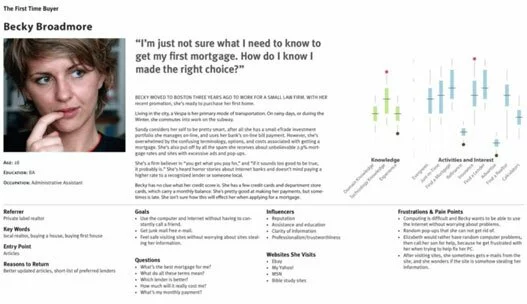
In the design process, there is no place for the “user of the product” - you should talk about a very specific person - about the character.
Characters are not real people, but they represent real people in the design process. These are hypothetical archetypes of real users. Being synthetic, they are nevertheless determined rigidly and precisely. In practice, the process of creating characters is rather not “inventing”, but the result of analytical work on user research, usage contexts and other information.
The main categories of users are defined, profiles are created for them, goals and tasks that these people solve to achieve the goal are worked out. Based on the tasks, the visual representations of key objects (interface solutions) and the way of interaction with the user are determined. And only after that the creation of the product begins. (You can learn more about the characters from the sources at the end of the article).
The text of the report of Pavel Konoplitsky at the conference SocialExperience 2008
Different users - different needs

The success of market leaders and the lack of user information, attempts to use the offline experience of creating a new product or service on the web often turn into a vicious belief that in order for a project to succeed, it must meet the interests of the maximum number of people.
Yes, a mass product is popular and often has loyal admirers, but individuality and individual approach are always highly valued. It would seem that social networks, having so much information about the user and his behavior, are able to provide such an individual approach, but according to the results of the research conducted by Prospectiv , most users claim that irrelevant advertising is shown to them.
')

Here is an example of what would happen if a car manufacturer decided to create a mass product that meets the needs of all consumer groups.

Meanwhile, it is only necessary to focus on the needs and on the representative of the consumer group - and it immediately becomes clear what product he needs.

All people are different. Everyone has their own needs, preferences, habits. Everyone has their own way of life and behavior. When creating a project, it is better to immediately realize as clearly as possible the needs and motivation of the audience for which your project is designed.
Do followers have a chance?
When a company has captured a market niche, first offering demanded functionality, there is little point in rushing to enter the market with an equivalent product. You have already lost in time to market, and no speed will change that. However, there is a real opportunity, if not to take away the leadership from the pioneer, then certainly - to fight for the user's attention. This is a better design. Design makes your product desirable, and users strive to own the most desirable products.This approach is applicable and works not only for the web. A very illustrative example is the iPhone from Apple. The company, which had not previously manufactured telephones, was able to create the desired product for many in one of the most competitive markets. That is the power of quality design!

For projects leading the so-called. "a long tail". For success it is not necessary for everyone to like the project. It is enough to satisfy for 100% the needs of a specific group.
Such long tails, if you look closely, are visible in almost every large project. Personally, I see such a tail on the seemingly long-standing market of dating sites. Now both leaders, Mamba and Loveplanet , combine elements of the so-called. “Light” (flirting) and “heavy” dating (acquaintance with the purpose of creating a family). The huge difference between the goals of these two different acquaintances is clear. A partner for creating a family is not searched by eye color, height or weight. Standard characteristics are clearly not enough, and there can be several pages of relevant results, because people are looking for a single life partner. In turn, those who seek a relationship without commitment can do the standard characteristics describing the appearance and results of a few pages exactly what you need. But with relevance again problems, because the results mix the participants of the first category (those who intend to start a family). People with polar interests are kept on the same site and are taught to play by the same rules.
How to know your users?
"Segmentation ... Marketing ... I know about this!" - you might say. Indeed, marketing research, like surveys and focus groups, can be a valuable source of general information about users. However, do not rely on offline marketing experience. In a non-internet business, marketers often come up with fictitious needs for their customers to support product sales, and then supposedly solve these “problems” by purchasing goods.
Will women learn to love vodka?

Detergent, eliminating the "water stone" that does not exist in nature
Marketers are usually willing to connect to the process of creating characters (a tool to focus on the user's goals, which will be discussed further), because it is very similar to what they do at the market definition stage. However, there is an important difference between the characters of marketing and the characters of designing: the first are created on the basis of demography and sales channels, and the latter are based only on the user.
These are not the same characters, although they serve the same purpose. Marketing characters shed light on the sales process, while design characters shed light on the development process.

"Spherical horses in a vacuum" - one of the extremes of the concept of users. These are people who do not make mistakes (fill in all the fields of the form correctly, enter data in full, etc.), use all services, act in accordance with the logic built into the system.


If there is no design stage in the development process, all project participants (developers, customer, managers) “mold” their user image. In one place of the system, they insert complex operations designed for an experienced user, in the other - they create a master for an agreeable beginner. Such a “gutta-percha” user silently tolerates everything that is attributed to him. “The user will need to print!”, “He wants to set it up - you need to make the settings!”, Etc. Real users are not like that. They act (and often make mistakes) according to their logic.
Who are the characters and why are they needed?

In the design process, there is no place for the “user of the product” - you should talk about a very specific person - about the character.
Characters are not real people, but they represent real people in the design process. These are hypothetical archetypes of real users. Being synthetic, they are nevertheless determined rigidly and precisely. In practice, the process of creating characters is rather not “inventing”, but the result of analytical work on user research, usage contexts and other information.
The main categories of users are defined, profiles are created for them, goals and tasks that these people solve to achieve the goal are worked out. Based on the tasks, the visual representations of key objects (interface solutions) and the way of interaction with the user are determined. And only after that the creation of the product begins. (You can learn more about the characters from the sources at the end of the article).
Goals ≠ tasks
At the conceptual design stage, clearly consider the goals that the user sets himself and the tasks that he will solve with the help of your product. What are his motives? Why should he choose your product? Here, it is worth remembering the goals and objectives:- The goal of any activity always lies outside the activity itself. The goal is the final state, while the task is the transition process necessary to achieve the goal. Tasks are subject to change, goals are not. Contrasting goals and objectives are very often. Anecdotal, but an excellent example of such an opposition is US President George W. Bush. When he wants peace to come somewhere, he ... sends infantrymen and equipment there. His task is war, his goal is peace. (An example from the training of Radislav Gandapas)
Living example
Let us analyze a practical example of how targeting a user's goals allows creating and monetizing new services, creating communication around a product. Synthesizing a character.
Olga Rogol, 27 years old, higher education. He lives in Moscow, near the metro station Novogireyevo. Works as an accountant in a construction company. Olga is not married. He lives with a young man who has a birthday in two weeks. Olga decides to give him a surprise by giving him his favorite toilet water - Versace Man Eau Fraiche 100ml. Being a regular customer of the Arbat-Prestige store and having a discount in it, Olga decides to look at the toilet water she is interested in in the assortment of this store. To do this, she goes to the store's website.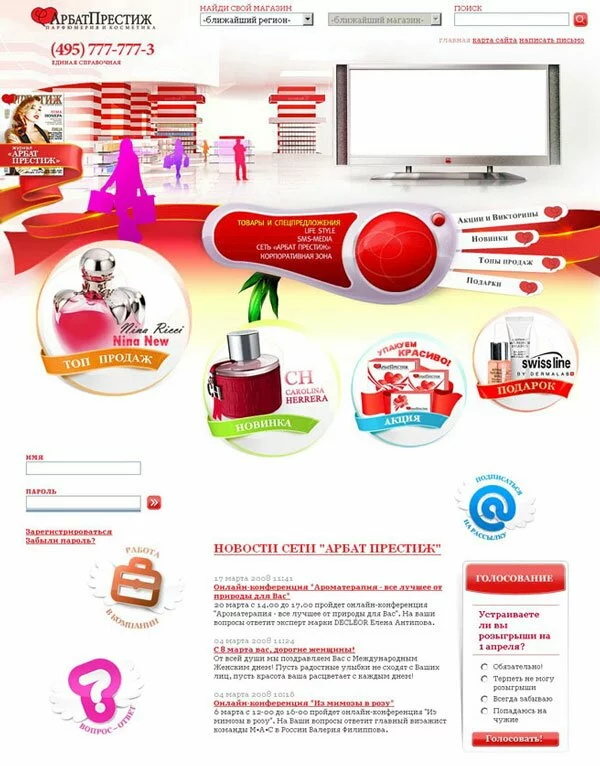
On the site, Olga is primarily interested in two things:
1. The presence of this toilet water in the assortment of the store
2. Its price.
Here, it would seem, the link most suitable within sense: "Goods and special offers". But for some reason this link is not to the catalog of goods and special offers, but a link to the main page.
Olga tries to find the product catalog page through the site map . She has the opportunity to see all the commercials of the store, the company's internal documents , the articles of association , annual reports , information about bonds, perfumery magazine ... Olga can not find why she came to this site.
Its page of interest is called “ Our brands ” and it’s impossible to get there except through the site map.
The selection of a suitable brand in the brand catalog is also not able to clarify any of Olga’s questions, which she came to solve with the help of the site. The site offers Olga the most to choose (!!!) the store where there are products of this brand. After this, the transition to the store page.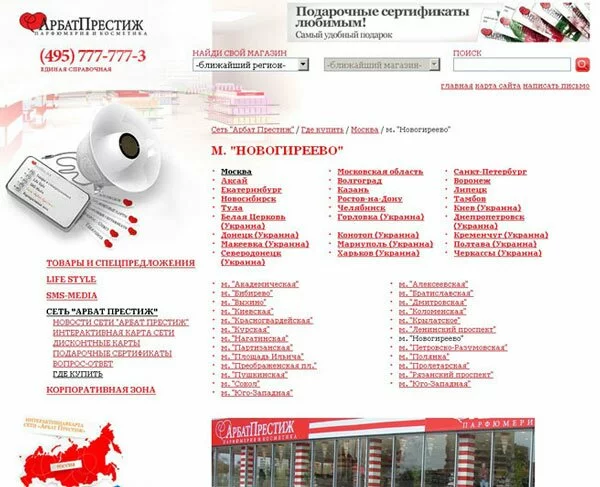
In the template several more times the opportunity is given to choose a store (in the header of the site and the entire content space up to the “fold line”). Olga has already indicated the store in the brand catalog, but the site ignorantly ignores this. In other stores from the given list of the selected brand may not be. Is it even possible to get the necessary information for Olga on the Arbat Prestige website? After a long search on the site, in the FAQ section, she finds words that put an end to these searches.
Olga cannot complete her task using the Arbat Prestige website. A user-oriented site can not only promote sales, but also organize communications around the product. So, what could the site of the Arbat-Prestige store give Olga and how can targeting the user's goals and objectives bring additional profit to the owners? Using the example of the Arbat-Prestige site, this could be implemented in the following functionality and services:- Structured product catalog (brands are not the only way of structuring). Link to which is available from the first page of the site. The search should produce relevant results for queries entered with errors (as Google is doing now). The site takes into account that Olga could only hear the name of the brand and not necessarily know its correct spelling (for example, it is not so easy to correctly write YVES SAINT LAURENT). The site informs Olga about upcoming sales and discounts. Mailing is possible, and it should be as relevant as possible to Olga’s preferences. The main emphasis should be placed on discounts on the perfume products that Olga has already bought, on products of the same brand and on similar (by price and category) products of other brands. And information about discounts should be primarily from those stores in which she already bought something and from the closest to the house. If the site knows about Olga's tastes, then he can notify her about the appearance of new products from the brand she likes. And not only in the mailing lists, but also generate content in accordance with this knowledge. For better implementation, data and customer research will be needed. For example, for those who prefer conservative flavors, you can either not do news updates, or very rarely. Conversely, those who prefer to change the flavors and follow the news, send more often. This is achieved by integrating the loyalty system of the store with the site, using thesauri and facet structuring.
New services for the site
The Wish List service would seem to surprise no one. How does it work on other sites? You select products in the product catalog, and you are offered to set the code for the list of desired products on your blog or give a link to your page with such a list on the site (specialized websites, compiling wish lists).
However, in the first place, not everyone maintains their own blogs or create accounts on sites to compile wish lists. Secondly, too much publicity of their desires is unusual for the majority of people (someone may consider this as “asking” for a gift, it is not common for someone to spread about their desires, etc.). Thirdly, this does not exclude the fact that several people can make the same surprise.
The new service, which I offer, gives Olga the opportunity to add the selected item to her wish list. Moreover, it should be possible to indicate a specific date by which she would like to receive a gift, and an e-mail of the person who gave it. (Moreover, different goods and different dates can be assigned to different e-mail addresses. “The one who is not the first is the second,” Irina Allegrova sings. Girls are so windy, therefore, interface solutions close to the needs of real life are much more attractive for your business.) Then, a few days before the date specified by Olga, the service sends a letter to her boyfriend's e-mail with the following text: “Only between us. Do you want to know a little more about Olga Rogol's wishes? ” Earlier, before this letter, the service sends a letter to Olga, where he asks to confirm the sending of the letter in order to avoid possible incident situations (already dispersed, etc.).
Another service that I offer is “Postpone until arrival”. The service allows Olga to postpone the selected product (after authorization) before arriving at the store. There are no queues (“unceasing flow of customers”), the goods are exactly in stock, packed and prepared for arrival.Our world is fixated on functions.
Remember how often when buying a particular thing, the number of functions becomes decisive. Many functions can be implemented in your product or service, but all of them may ... not meet the user's expectations. Do not believe? Then imagine a product with the following features and functions:- Internal combustion engine; Four wheels with rubber tires; Transmission linking the engine with drive wheels; Steering wheel Presented? Here he is! . I hope you presented this and the user was able to complete his tasks with the help of the product you presented.
Social networking functionality
Modern startup creators often think only about monetization, and not about creating value for the user, the presence of which is precisely the key to successful monetization of the project. Alexey Andreev (webplaneta) touched upon the topic of motivating users of social networks and services . A particularly vivid example is the millionaires who are so trying to get their hands on the “network for the rich”. (Indeed, it is true: now millionaires do not have enough internal or external motivation to register and take an active part in the life of social networks). Nevertheless, project creators continue to invent artificial needs not only at the conceptual level (“network for millionaires”, “network of intellectuals”, etc.), but also in functionality on their sites.
One of the needs of users of social networks can be described as “to show oneself, to see others”.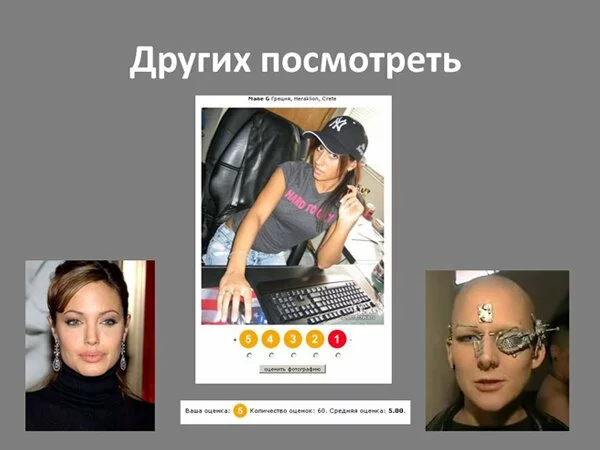
Once I witnessed the next dialogue. Two girls in the subway across from me were talking about Odnoklassniki.
- You know, my ex put the “five” of that photo, where I am in a white blouse, and the “number” - the one where I and our colleague Anton - the first one said.
- Here is a jealous man, - answered the second.
The main functionality of the scale is to evaluate the object based on their own feelings (between the worst and best, high and low, large and small, etc.) Users of the Odnoklassniki social network do not put the same meaning into the photo rating scale created by the authors of Odnoklassniki. (The artificial needs of the user expressed in the functions. Remember? "Gutta-percha user"). People are offended by any assessment below the "five". Even if the photo is far from a highly artistic picture and Kohl is not depicted in a presentable form, or if Vera has red eyes and a bad angle, the score below the “five” will often be offensive. I do not urge you to try to give a low rating to your acquaintances, but I think that not many of you will then be able to find for them a sensible explanation of the reason for your action. If users are not familiar with each other, then grading is more like the functionality of “Wink” on dating sites. If the photos are viewed by acquaintances, then “put up the fives” are part of the ritual of viewing. Therefore, the average rating of most photographs of users of "Classmates" is 5.
Another need is familiarity. Daiting comes to social networks. And both “heavy” dating, and “light”. Natural desire, free choice of everyone. Here is an example of a widget for facebook, a social network that has an open API and allows developers to extend the functionality of the system and make money on it. (Earn by satisfying the needs of its users).
On the Odnoklassniki website, people get to know each other, but the developers brought the “Dating” section separately to the main menu on the left. What is this dating? The user is sent to the Mamba system, where he needs to register again (the services are not integrated and each requires his own username and password). Although now, in order to plunge into the abyss of love passions in Odnoklassniki, the user is hampered by only one mandatory field “Last Name” in the search for people (look at the search form by clicking on the “Search for people” link in your classmates profile).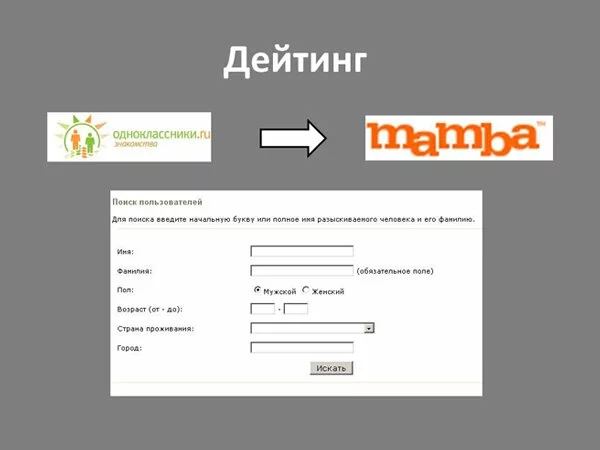
Pay attention: one interface solution constrains the whole layer of interaction between users. By removing only one requirement of mandatory filling in one field, one can become the initiator of the creation of several new families or stories like “lost and thrown”.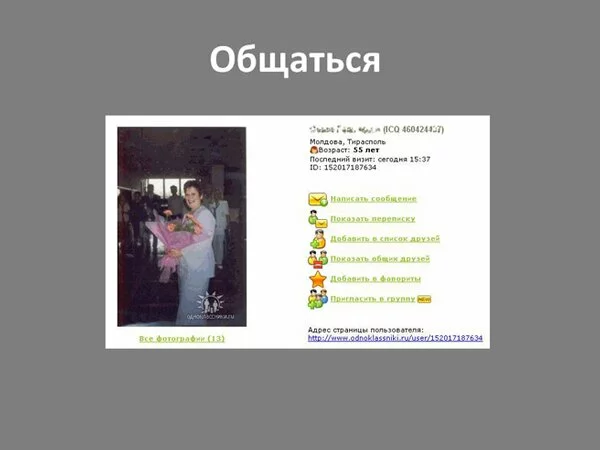
Users want to continue the communication, which began in social networks. Almost all social networks see this as a threat to reduce attendance. However, people do not hide their needs, so it is important to learn how to hear their users. In Odnoklassniki, the desire of users to continue communication manifests itself in, for example, that they write their ICQ numbers in the “Last Name” field.
Unite in groups - another need to be noted. At Odnoklassniki it was recently implemented. Now users are given complete freedom to create any groups. My vision of this functionality for a site that is positioned as a site with real people is to narrow down the group that the user is already in. For example, you specified the school and the years of study, respectively, the next group, which is obvious from this data, will be a class (letter). Of course, some caution is needed here to avoid the same situation as with the names of schools and universities, as well as taking into account special cases (someone studied in several classes of the same school, etc.). Evidence of the need to unite in such groups can be considered cases of the publication of collective photographs in their profiles.Remember the people
Do not forget about real people! People, unlike characters, can answer questions. People have an opinion. People can say if something is wrong or something is incomprehensible. People change. People are wrong. People use your products.I recommend reading:
- Usability Bulletin # 14 (UPA) - K. Gaddy, A. Marcus. ABC of the analysis of user tasks in web design Alan Cooper's book "Mental hospital in the hands of patients" (quotes from this book were used in the text)
Todd Zaki Warfel. Data Driven Design Research Personas
Andrew Hinton. Personas and the Role of Design Documentation
Jesse James Garrett's book Elements of Interaction Experience Ask 37signals: Personas?
The book by Alan Cooper "About Face 3: The Essentials of Interaction Design"
The Book By John Pruitt, Tamara The Persona Lifecycle: The Morgan Kaufmann Series In Interactive Technologies
Other books on usability and information architecture
Download the presentation in ppt or pdf format.
Watch video performances
View presentation
First published in the Usability Bulletin. Issue number 20
- Usability Bulletin # 14 (UPA) - K. Gaddy, A. Marcus. ABC of the analysis of user tasks in web design Alan Cooper's book "Mental hospital in the hands of patients" (quotes from this book were used in the text)
- Internal combustion engine; Four wheels with rubber tires; Transmission linking the engine with drive wheels; Steering wheel Presented? Here he is! . I hope you presented this and the user was able to complete his tasks with the help of the product you presented.
- Structured product catalog (brands are not the only way of structuring). Link to which is available from the first page of the site. The search should produce relevant results for queries entered with errors (as Google is doing now). The site takes into account that Olga could only hear the name of the brand and not necessarily know its correct spelling (for example, it is not so easy to correctly write YVES SAINT LAURENT). The site informs Olga about upcoming sales and discounts. Mailing is possible, and it should be as relevant as possible to Olga’s preferences. The main emphasis should be placed on discounts on the perfume products that Olga has already bought, on products of the same brand and on similar (by price and category) products of other brands. And information about discounts should be primarily from those stores in which she already bought something and from the closest to the house. If the site knows about Olga's tastes, then he can notify her about the appearance of new products from the brand she likes. And not only in the mailing lists, but also generate content in accordance with this knowledge. For better implementation, data and customer research will be needed. For example, for those who prefer conservative flavors, you can either not do news updates, or very rarely. Conversely, those who prefer to change the flavors and follow the news, send more often. This is achieved by integrating the loyalty system of the store with the site, using thesauri and facet structuring.
Source: https://habr.com/ru/post/29713/
All Articles